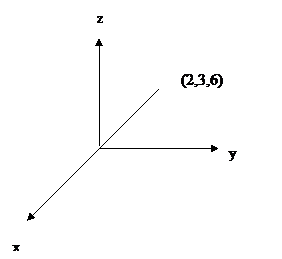MATHS :: Lecture 01 :: 3D Analytical Geometry
![]()
Three dimensional Analytical geometry
Let OX ,OY & OZ be mutually perpendicular straight lines meeting at a point O. The extension of these lines OX1, OY1 and OZ1 divide the space at O into octants(eight). Here mutually perpendicular lines are called X, Y and Z co-ordinates axes and O is the origin. The point P (x, y, z) lies in space where x, y and z are called x, y and z coordinates respectively
. 
where NR = x coordinate, MN = y coordinate and PN = z coordinate

Distance between two points
The distance between two points A(x1,y1,z1) and B(x2,y2,z2) is
dist AB = ![]()
In particular the distance between the origin O (0,0,0) and a point P(x,y,z) is
OP = ![]()
The internal and External section
Suppose P(x1,y1,z1) and Q(x2,y2,z2) are two points in three dimensions.
![]()
P(x1,y1,z1) A(x, y, z) Q(x2,y2,z2)
The point A(x, y, z) that divides distance PQ internally in the ratio m1:m2 is given by
A = |
Similarly
P(x1,y1,z1) and Q(x2,y2,z2) are two points in three dimensions.
![]()
P(x1,y1,z1) Q(x2,y2,z2) A(x, y, z)
The point A(x, y, z) that divides distance PQ externally in the ratio m1:m2 is given by
A = |
If A(x, y, z) is the midpoint then the ratio is 1:1
A = |
Problem
Find the distance between the points P(1,2-1) & Q(3,2,1)
PQ= ![]() =
=![]() =
=![]() =2
=2![]()
Direction Cosines
Let P(x, y, z) be any point and OP = r. Let a,b,g be the angle made by line OP with OX, OY & OZ. Then a,b,g are called the direction angles of the line OP. cos a, cos b, cos g are called the direction cosines (or dc’s) of the line OP and are denoted by the symbols I, m ,n
. Result
Result
By projecting OP on OY, PM is perpendicular to y axis and the![]() also OM = y
also OM = y
![]()
Similarly, ![]()
![]()
(i.e) l = ![]() m =
m = ![]() n =
n = ![]()
\l2 + m2 + n2 = ![]()
(![]() Distance from the origin)
Distance from the origin)
\ l2 + m2 + n2 = ![]()
l2 + m2 + n2 = 1
(or) cos2a + cos2b + cos2g = 1.
Note :-
The direction cosines of the x axis are (1,0,0)
The direction cosines of the y axis are (0,1,0)
The direction cosines of the z axis are (0,0,1)
Direction ratios
Any quantities, which are proportional to the direction cosines of a line, are called direction ratios of that line. Direction ratios are denoted by a, b, c.
If l, m, n are direction cosines an a, b, c are direction ratios then
a µ l, b µ m, c µ n
(ie) a = kl, b = km, c = kn
(ie) ![]() (Constant)
(Constant)
(or)  (Constant)
(Constant)
To find direction cosines if direction ratios are given
If a, b, c are the direction ratios then direction cosines are
![]()
![]() l =
l = ![]()
![]() similarly m =
similarly m = ![]() (1)
(1)
n = ![]()
l2+m2+n2 = 
(ie) 1 = 
![]()
Taking square root on both sides
K = ![]()
\
Problem
1. Find the direction cosines of the line joining the point (2,3,6) & the origin.
Solution
By the distance formula
![]()

Direction Cosines are r
l = cos µ = 
o

n = cos g =

2. Direction ratios of a line are 3,4,12. Find direction cosines
Solution
Direction ratios are 3,4,12
(ie) a = 3, b = 4, c = 12
Direction cosines are
l =

m=

n=

Note
- The direction ratios of the line joining the two points A(x1, y1, z1) &
B (x2, y2, z2) are (x2 – x1, y2 – y1, z2 – z1) - The direction cosines of the line joining two points A (x1, y1, z1) &
B (x2, y2, z2) are ![]()
r = distance between AB.
| Download this lecture as PDF here |
![]()


